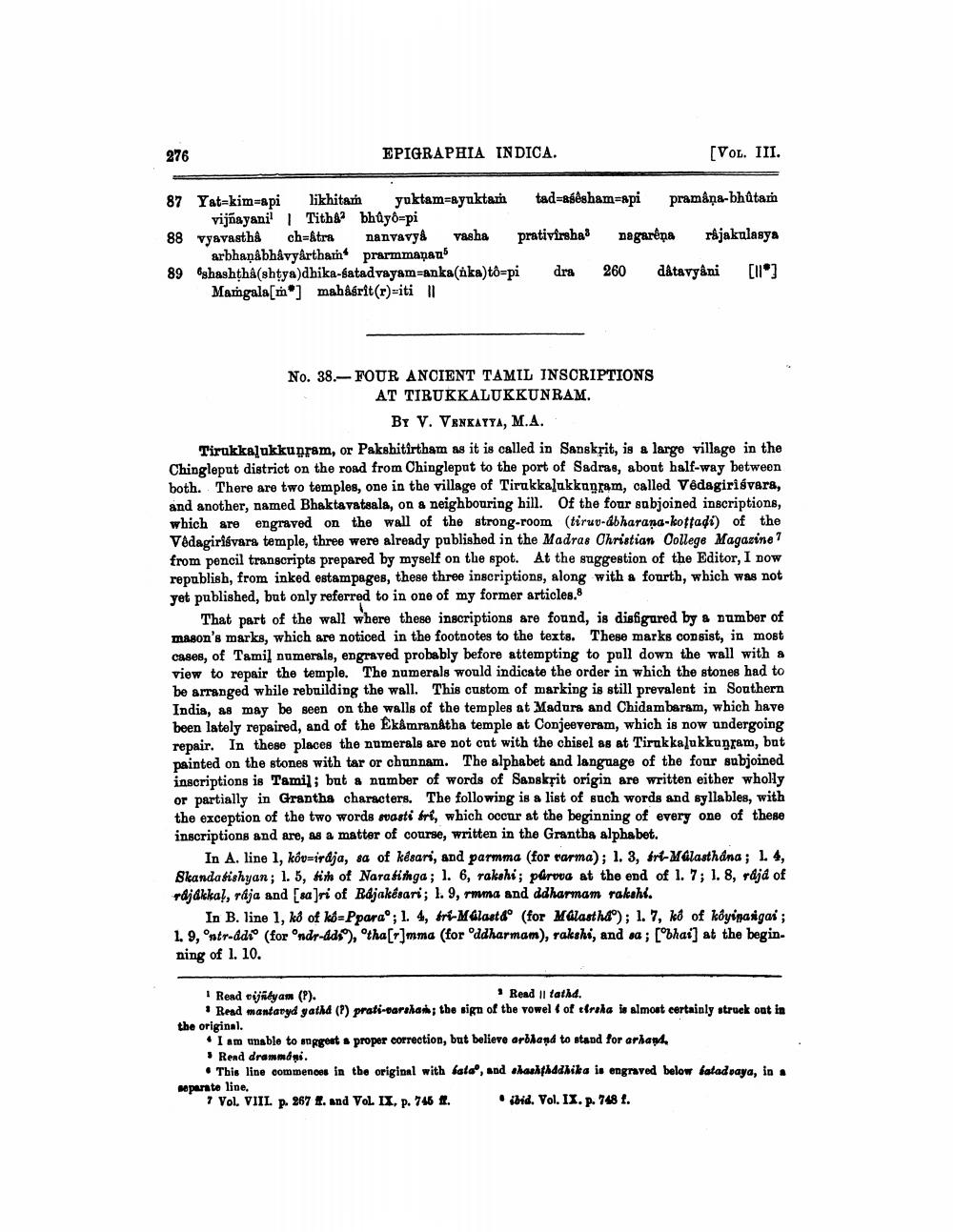________________
276
EPIGRAPHIA INDICA.
(VOL. III.
87 Yat-kim-api likhitam yuktam=ayuktam tad=asêsham=api pramåņa-bhůtam
vijñayani Titha bhay=pi 88 vyavastha ch=&tra nanvavy& vasha prativirsha) nagaréņa rajakulasya
arbhanabhävyárthat prarmmanan 89 6shashtha (shtya)dhika-fatadvayam=anka(úka)tô=pi d ra 260 datavyani [11]
Mangala[m] mahasrit(r)=iti 11
No. 38.-FOUR ANCIENT TAMIL INSCRIPTIONS
AT TIBUKKALUKKUNRAM.
BY V. VENKATTA, M.A. Tirukkalukkudram, or Pakshitirtham as it is called in Sanskrit, is a large village in the Chingleput district on the road from Chinglepat to the port of Sadras, about half-way between both. There are two temples, one in the village of Tirukkalukkagram, called Védagirisvara, and another, named Bhaktavatsala, on a neighbouring hill. Of the four subjoined inscriptions, which are engraved on the wall of the strong-room (tiruv-dbharana-kottadt) of the Védagirisvara temple, three were already published in the Madras Christian College Magazine ? from pencil transcripts prepared by myself on the spot. At the suggestion of the Editor, I now republish, from inkod estampages, these three inscriptions, along with a fourth, which was not yet published, but only referred to in one of my former articles.
That part of the wall where these inscriptions are found, is disfigured by a number of mason's marks, which are noticed in the footnotes to the texts. These marks consist, in most cases, of Tamil numerals, engraved probably before attempting to pull down the wall with a view to repair the temple. The numerals would indicate the order in which the stones had to be arranged while rebuilding the wall. This custom of marking is still prevalent in Southern Indis, as may be seen on the walls of the temples at Madurs and Chidambaram, which have been lately repaired, and of the Ekamranátha temple at Conjeeveram, which is now undergoing repair. In these places the numerals are not cut with the chisel as at Tirukkalukkuņram, but painted on the stones with tar or chunnam. The alphabet and language of the four subjoined inscriptions is Tamil; but a number of words of Sansksit origin are written either wholly or partially in Grantha characters. The following is a list of such words and syllables, with the exception of the two words sasti frí, which occur at the beginning of every one of these inscriptions and are, as a matter of course, written in the Granths alphabet.
In A. line 1, kôv=irdja, sa of késars, and parmma (for carma); 1. 3, 6rl-Malasthana ; L. 4, Skanda tishyan; 1. 5, fish of Naratishga; 1. 6, rakshi; paruva at the end of 1.7; 1. 8, raja of rdjakkal, raja and [sa]ri of Rajakesari; 1. 9, roma and ddharmam rakshi.
In B. line 1, k8 of k=Pparao; 1. 4, 6r1-MGlast&o (for Malasthao); 1. 7, ked of köyipasigas; 1. 9, Ontr-ddio (for Ondr-dd), tha[r]mma (for 'ddharmam), rakshi, and sa; [hai] at the begin. ning of 1. 10.
Read dijilyam (P).
* Read li tatha. * Read mantaryd yatha (P) prati-varshan; the sign of the vowel of frala lo almost certainly struck out in the original.
• I am unable to mpgest a proper correction, but believe arbland to stand for arhana . Rend drammáni.
• This line commences in the original with bata', and shashadhika is engraved below baladvaya, in reparte line.
7 Vol. VIIL p. 267 1. and VoL IX, p. 746 1. ibid. Vol. IX. p. 748 .




